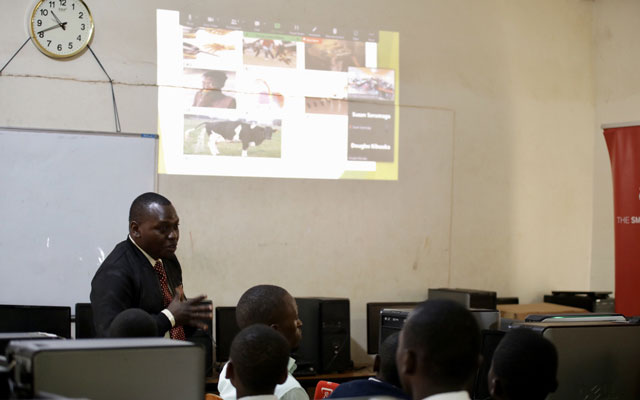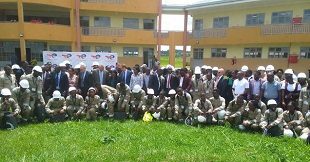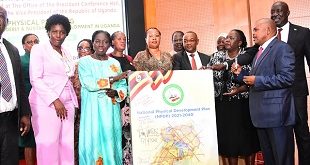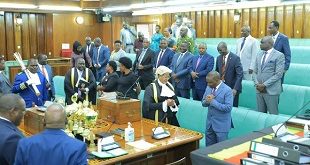
Adjumani, Uganda | THE INDEPENDENT | It was a groundbreaking Monday at St Mary’s Asumputa Senior Secondary School in Adjumani District as senior one students were treated to a biology lesson conducted from Kitende Secondary School over 480 kilometres away.
The two schools were linked seamlessly thanks to video conferencing technology enabled through a partnership between the United Nations Children’s agency-UNICEF, the Ministry of Education and Sports, and Airtel Uganda.
Martin Kisitu, a biology teacher, led the lesson from Kitende SS, amidst excitement and anticipation as the students eagerly listened to the interlinked lesson. With the question posed, “How can you tell that this is a living thing?” the teacher at Kitende expected an answer from a student miles away and the learners in Adjumani confidently provided answers to the questions.
Catherine Ntabadde, the communication specialist at UNICEF explains that the tele-teaching and learning program has two key components. First, the video conferencing aspect of the program enables teachers from urban schools to connect with students in rural schools and learners access to a web-based e-Learning platform called Kolibri.
“The tele-teaching and learning program is currently in its pilot phase and will cover ten schools, for starters. These schools have been carefully selected to include both urban and rural areas, and they will be linked to facilitate cross-school learning through the tele-teaching,” Ntabadde says.
She added that this initiative is revolutionizing the education landscape in Uganda and providing a platform for students to learn and grow regardless of their geographical location.
As part of the launch, @UNICEF and @Airtel_Ug
have connected Kitende Secondary School to the internet and an online lesson delivered from Kitende, attended by learners of St. Mary Assumpta Girls Senior Secondary School, 📍Adjumani District, simultaneously.#InvestInUGchildren pic.twitter.com/Z2noMEoKIP— UNICEF Uganda (@UNICEFUganda) March 20, 2023
According to Ntabadde, the web-based e-Learning platform on this initiative will offer a range of educational resources that have been approved by the National Curriculum Development Centre (NCDC) and will be open to all learners across the country.
As part of the arrangement, Airtel has committed to zero-rating the platform, which means that all learners will be able to access it at no cost. Airtel will be connecting the ten piloting schools with free, unlimited data to ensure that they can conduct lessons with ease.
During the first lesson, our reporter who attended the class from Kitende observed a mix of emotions, including enthusiasm, excitement, and some disappointments.
The teacher chose a topic typically taught on the first day of senior one class, and the students from both schools followed quite well. They were actively engaged in the lesson and contributed to the discussion revolving around the characteristics of living things.
For the learners that attended the classroom from Kitende, this was an exciting moment. “this means we can also have lessons with students from other big schools,” one learner commented.
However, the teacher was let down by the poor network connectivity which created a lag between the two classes. As a result, there were occasional delays in responses from learners at St Mary’s forcing the teacher to often focus on the students in his physical presence, bringing to the fore, a well-known challenge of poor internet connectivity in many areas of the country.
From observation, our reporters also pointed out that the teacher was struggling to teach the two classes and had not received proper training on how to deliver a teleconference lesson. The teacher was simply applying traditional teaching methods designed to work in a four-walled classroom. However, it became evident that this approach was not entirely effective.
Students St. Mary's Assumpta Secondary School celebrating Digital Education Partnership @UNICEFUganda @Airtel_Ug @Educ_SportsUg pic.twitter.com/2Xjt85e1wz
— Sacha Westerbeek (@SachaWesterbeek) March 20, 2023
Later, he personally noted that while he had some basic knowledge, he lacked training in this particular mode of teaching.
Dr Stephen Ndawula, a specialist in education technology at Kyambogo University observed a need for teacher training on how to effectively deliver lessons in a blended learning environment that combines traditional classroom teaching with technology-enabled learning.
“…this may require a shift in teaching methodologies, the use of more interactive and engaging teaching tools, and ongoing support and training for teachers to ensure they are able to adapt to new and changing learning environments. We can’t teach such a lesson just we teach a traditional classroom,” Ndawula said.
Dr Ndawula added that many teachers lacked the necessary skills and knowledge to effectively teach in digital environments during the COVID-19 pandemic, leading to suboptimal outcomes for both teachers and students.
“Teaching via TV, radio, YouTube, or tele-teaching requires a different skill set than teaching in a physical classroom, and teachers must be properly trained to adapt to these new formats. Without adequate training, the success of tele-teaching programs is at risk,” he warned.
Juliet Nesakya, the deputy headteacher of Kitende S.S., also expressed concern about the lack of ICT equipment and other enablers in many schools in Uganda.
“Without computers, students are unable to access online resources. Here we have only 35 computers for a school of 1,800 learners and parents can’t afford to purchase smartphones or laptops for their children. The situation is worse in rural areas. There is also an issue of access to electricity. Although we have benefited from the project, there is still a need for more support,” she said.
Uganda has previously piloted a similar learning mode on more than two occasions, with UNESCO and Uganda Communication Commission. The recent one was dubbed the Holistic e-Learning Project (HeLP) under UCC’s Rural Communication Development Fund.
The project was set in four schools including Gayaza High School, St. Mary’s College Kisubi, Nabisunsa Girls’ School, and Busoga College Mwiri. These schools were selected by UCC because they already had e-Learning infrastructure in place, which had been installed through a separate project a few years prior.
As per their project brief, their goal was to connect schools in remote areas with a centralized lesson delivery system. This would involve delivering a lesson at a single location and broadcasting it simultaneously to at least 100 schools, enabling learners in these schools to access the lesson at the same time.
****
URN
 The Independent Uganda: You get the Truth we Pay the Price
The Independent Uganda: You get the Truth we Pay the Price


